Zonation of Landslide Susceptibility in Ruijin, Jiangxi, China
Abstract
1. Introduction
2. Data and Methods
2.1. The Study Area
2.2. Field Survey Data
2.2.1. Observed Mechanisms
2.2.2. Triggering Factors
2.3. Data and Processing Procedures
2.3.1. Geo-Environmental Data and WA-Based Processing
Satellite Data
- (1)
- Landsat imagery: Landsat 5 TM images of late October and early November from 2006–2010 and Landsat 8 OLI images dated May 2017 and Sept 2019 were obtained from the USGS data server (https://glovis.usgs.gov, accessed on 20 May 2020). After atmospheric correction using the COST model [23,43,44], Landsat 8 images were employed for land cover mapping using the approach proposed by Wu et al. (2016) [7] and Landsat 5 data for deriving the averaged multiyear autumn NDVI (Figure 3a).
- (2)
Hydrological Data
- (1)
- Rainfall: Monsieurs et al. (2018) and Depicker et al. (2020) stated that rainfall was the direct cause, or rather, the triggering factor of many landslides [38,48]. Daily rainfall data from January 2008 to December 2013 were obtained from 40 meteorological stations in Ruijin and its adjacent areas. As the landslides mainly occurred in March to July, especially, in June and July but without detailed recorded occurrence time, our intention was to investigate which months of rainfall or their combinations may best reveal its role in landslide events. Thus, apart from the mean annual rainfall, March-June, May-July and March-July rainfalls of these six years were also aggregated and gridded into raster with 30 m pixel size using the inverse distance weighting (IDW) approach.
- (2)
- River network: The influence of rivers on the occurrence of landslides is reflected by the proximity to, or rather, distance from rivers [21,49,50]. Thus, the rivers were vectorized from Google Earth (Figure 3b) and buffered into belts with an interval of 30, 60, 90, 120, and 150 m, respectively, for streams, and 60, 120, 180, 240, and 300 m, respectively, for the main rivers. Then, these buffers were assigned values in terms of their propensity or their importance in the event of a landslide based on the field knowledge and expert judgment. For example, for the main river buffers of 0–60, 60–120, 120–180, 180–240, and 240–300 m were respectively assigned with 20, 15, 10, 5, and 1, while for streams, buffer zones of 0–30, 30–60, 60–90, 90–120, and 120–150 m, respectively, with 10, 8, 6, 4, and 1. This implies that the closer to the river the higher the propensity of a landslide.
Geological and Geomorphic Data
- (1)
- Geological strata and formations: Geological strata were extracted from the 1/50,000 Geological Map. Except for Ordovician, Silurian, Triassic, and Tertiary, the strata of other geological periods are mostly exposed. In terms of texture and composition, the lithology of different strata in the study area can be divided into 113 classes. To facilitate the geohazard analysis, these lithological classes were further aggregated into six main categories: (1) granitic rocks, (2) magmatic veins, (3) metamorphic rocks, (4) sandstone, (5) limestone, and (6) mudstone and shales as shown in Figure 4a. Based on lithology and in absence of faults and joints, granitic massif would possess the highest resistance to landslides while mudstone the lowest resistance. Hence, from (1) to (6), the propensity is likely to increase and these were respectively assigned values of 1, 2, 3, 5, 7 and 10.
- (2)
- Faults: This kind of geological structure has a prominent effect on the stability of rock mass [51,52]. In the study area there is a spectacular thrust nappe structure characterized by strong faulting activity. Such a structure is accompanied with a series of faults and folds, which tend to be the landslide-prone areas, e.g., the fragile belts related to fold hinges, fracture zones, and joints. As a matter of fact, the proximity to fault plays a role in such hazard events, i.e., the closer to the fault, the higher the propensity of a landslide. For this reason, the faults in the study area (Figure 4b) were divided into three groups in terms of scale, i.e., big faults if their length is >10–20 km, medium faults if they are 2–10 km, and small faults if they are <2 km. The big faults were buffered into five zones of 0–120 m, 120–240 m, 240–360 m, 360–480 m, and 480–600 m, and were respectively assigned values of 20, 15, 10, 5, and 1. The medium faults were also buffered into five zones of 0–60 m, 60–120 m, 120–180 m, 180–240 m, and 240–300 m with assigned values of 10, 8, 6, 4, and 1. The small faults were again buffered into five zones of 0–30 m, 30–60 m, 60–90 m, 90–120 m, and 120–150 m and respectively assigned values of 5, 4, 3, 2, and 1. These fault buffers were gridded into a raster layer of 30 m in resolution.
- (3)
- Depth of the weathered crust, soil type, and texture: Weathering is the process of converting rocks into regolith and soils to constitute the weathered crust of our land surface. Landslides mostly take place in this crust in which soil texture seems to have a significant impact on [53,54] and the variability of soil types and depths of the crust play a part in the occurrence of such events [55]. Because different soil types and textures have different sand percentage, grain sizes and porosity affect the permeation of rain water. If liquidized by penetrated water, the crust bottom (soil/rock interface) may serve as a slip surface of a landslide as friction and resistance from the underlying rocks are reduced by this process. As soon as it has reached a certain threshold, a landslide occurs. Thus, the crust thickness, i.e., the depth of the slippery soil/rock interface, is a plausible indicator of landslide volume and scale.
- (4)
- Geomorphic data: Slope (angle) is a key driver of landslides and a triggering angle threshold of 28°–38° was reported by Fan et al. (2016) [55]; at the same time, elevation, aspect, plane curvature, and profile curvature may also contribute to the occurrence of the hazards [14,21,56,57,58]. The ASTGTMV003 GDEM data, with a spatial resolution of 30 m, were obtained for Ruijin from NASA (www.earthdata.nasa.gov, 11 April 2020) and used to derive elevation, slope, and aspect (Figure 1 and Figure 5a,b).
Land Use/Cover, Transport System and Construction Sites
2.3.2. SNL Processing for Categorical Factors
2.3.3. Frequency Ratio (FR)-Based Processing
2.3.4. Integrated Datasets of Geo-Environmental Factors
2.3.5. Training and Validation Sets
2.4. Landslide Susceptibility Modeling
2.4.1. RF Modeling of the Landslide Occurrence Probability
2.4.2. Application of the RF Algorithm
2.4.3. Importance of Variables
2.4.4. Accuracy Reporting
3. Results and Discussion
3.1. Landslide Susceptibility Maps
- (1)
- Very high susceptibility zones were mainly linearly distributed along the roads and rivers due to the fact that a number of landslides were often caused by river undercutting and artificial road construction and housing development.
- (2)
- In the central part of the study area, very high-susceptibility zones are concentrated in the Quaternary soil layer, or rather, in the weathered crust, especially along the boundaries of lithologic strata. The Quaternary unconsolidated soil layer with loose structure provided rich material for landslides. The boundaries of lithologic strata behaved as unstable structural interfaces, which appeared to be important factors for landslides.
- (3)
- In the granitic massif, there were also obvious very high-susceptibility zones distributed along the roads. Weathering accelerated by humidity, high undulating landform and tectonically active settings of the study area change the intrinsic properties of the material and reduce the strength of the near-surface rocks.
3.2. Number of Trees with RF Modeling
3.3. FR and Importance of Geo-Environmental Factors
3.4. Validation of the Modeling Results
3.5. Case Verification
4. Conclusions
Author Contributions
Funding
Data Availability Statement
Acknowledgments
Conflicts of Interest
References
- Wu, W.; Ai, G. Risk assessment of natural disasters in the course of selection of nuclear waste disposal (in Chinese with English abstract). J. East China Geol. Inst. 1995, 18, 260–265. [Google Scholar]
- Nadim, F.; Kjekstad, O.; Peduzzi, P.; Herold, C.; Jaedicke, C. Global landslide and avalanche hotspots. Landslides 2006, 3, 159–173. [Google Scholar] [CrossRef]
- Assilzadeh, H.; Levy, J.K.; Wang, X. Landslide catastrophes and disaster risk reduction: A GIS framework for landslide prevention and management. Remote Sens. 2010, 2, 2259–2273. [Google Scholar] [CrossRef]
- Froude, M.J.; Petley, D.N. Global fatal landslide occurrence from 2004 to 2016. Nat. Hazards Earth Syst. Sci. 2018, 18, 2161–2181. [Google Scholar] [CrossRef]
- Petley, D. Global patterns of loss of life from landslides. Geology 2012, 40, 927–930. [Google Scholar] [CrossRef]
- Aleotti, P.; Chowdhury, R. Landslide hazard assessment: Summary review and new perspectives. Bull. Eng. Geol. Environ. 1999, 58, 21–44. [Google Scholar] [CrossRef]
- Wu, W.; Zucca, C.; Karam, F.; Liu, G. Enhancing the performance of regional land cover mapping. Int. J. Appl. Earth Obs. Geoinform. 2016, 52, 422–432. [Google Scholar] [CrossRef]
- Arabameri, A.; Saha, S.; Roy, J.; Chen, W.; Blaschke, T.; Tien Bui, D. Landslide susceptibility evaluation and management using different machine learning methods in the Gallicash River Watershed, Iran. Remote Sens. 2020, 12, 475. [Google Scholar] [CrossRef]
- Montgomery, D.R.; Dietrich, W.E. A physically based model for the topographic control on shallow landsliding. Water Resour. Res. 1994, 30. [Google Scholar] [CrossRef]
- Guzzetti, F.; Carrara, A.; Cardinali, M.; Reichenbach, P. Landslide hazard evaluation: A review of current techniques and their application in a multi-scale study, Central Italy. Geomorphology 1999, 31, 181–216. [Google Scholar] [CrossRef]
- Ayalew, L.; Yamagishi, H. The application of GIS-based logistic regression for landslide susceptibility mapping in the Kakuda-Yahiko Mountains, Central Japan. Geomorphology 2005, 65, 15–31. [Google Scholar] [CrossRef]
- Ruff, M.; Czurda, K. Landslide susceptibility analysis with a heuristic approach in the Eastern Alps (Vorarlberg, Austria). Geomorphology 2008, 94, 314–324. [Google Scholar] [CrossRef]
- Arabameri, A.; Pourghasemi, H.R.; Yamani, M. Applying different scenarios for landslide spatial modeling using computational intelligence methods. Environ. Earth Sci. 2017, 76, s12665–s017. [Google Scholar] [CrossRef]
- Corominas, J.; van Westen, C.; Frattini, P.; Cascini, L.; Malet, J.P.; Fotopoulou, S.; Catani, F.; Van Den Eeckhaut, M.; Mavrouli, O.; Agliardi, F.; et al. Recommendations for the quantitative analysis of landslide risk. Bull. Eng. Geol. Environ. 2014, 73, 209–263. [Google Scholar] [CrossRef]
- Reichenbach, P.; Rossi, M.; Malamud, B.D.; Mihir, M.; Guzzetti, F. A review of statistically-based landslide susceptibility models. Earth Sci. Rev. 2018, 180, 60–91. [Google Scholar] [CrossRef]
- Li, L.; Lan, H.; Guo, C.; Zhang, Y.; Li, Q.; Wu, Y. A modified frequency ratio method for landslide susceptibility assessment. Landslides 2017. [Google Scholar] [CrossRef]
- Goetz, J.N.; Brenning, A.; Petschko, H.; Leopold, P. Evaluating machine learning and statistical prediction techniques for landslide susceptibility modeling. Comput. Geosci. 2015, 81, 1–11. [Google Scholar] [CrossRef]
- Furlani, S.; Ninfo, A. Is the present the key to the future? Earth Sci. Rev. 2015, 142, 38–46. [Google Scholar] [CrossRef]
- Zhu, A.X.; Miao, Y.; Liu, J.; Bai, S.; Zeng, C.; Ma, T.; Hong, H. A similarity-based approach to sampling absence data for landslide susceptibility mapping using data-driven methods. Catena 2019, 183. [Google Scholar] [CrossRef]
- Huang, F.; Cao, Z.; Guo, J.; Jiang, S.H.; Li, S.; Guo, Z. Comparisons of heuristic, general statistical and machine learning models for landslide susceptibility prediction and mapping. Catena 2020. [Google Scholar] [CrossRef]
- Cao, J.; Zhang, Z.; Wang, C.; Liu, J.; Zhang, L. Susceptibility assessment of landslides triggered by earthquakes in the Western Sichuan Plateau. Catena 2019, 175, 63–76. [Google Scholar] [CrossRef]
- Gritzner, M.L.; Marcus, W.A.; Aspinall, R.; Custer, S.G. Assessing landslide potential using GIS, soil wetness modeling and topographic attributes, Payette River, Idaho. Geomorphology 2001, 37, 149–165. [Google Scholar] [CrossRef]
- Wu, W. Application de la Géomatique au Suivi de la Dynamique Environnementale en Zones Arides (in French). Ph.D. Thesis, Université de Paris 1-Panthéon-Sorbonne, Paris, France, 2003. [Google Scholar]
- Wang, H.B.; Liu, G.J.; Xu, W.Y.; Wang, G.H. GIS-based landslide hazard assessment: An overview. Prog. Phys. Geog. 2005, 29, 548–567. [Google Scholar] [CrossRef]
- Lai, J.S.; Chiang, S.H.; Tsai, F. Exploring Influence of Sampling Strategies on Event-Based Landslide Susceptibility Modeling. ISPRS Int. J. Geo Inf. 2019, 8. [Google Scholar] [CrossRef]
- Chang, Z.; Du, Z.; Zhang, F.; Huang, F.; Chen, J.; Li, W.; Guo, Z. Landslide susceptibility prediction based on remote sensing images and GIS: Comparisons of supervised and unsupervised machine learning models. Remote Sens. 2020, 12. [Google Scholar] [CrossRef]
- Youssef, A.M.; Maerz, N.H.; Hassan, A.M. Remote sensing applications to geological problems in Egypt: Case study, slope instability investigation, Sharm El-Sheikh/Ras-Nasrani Area, Southern Sinai. Landslides 2009, 6, 353–360. [Google Scholar] [CrossRef]
- Wasowski, J.; Bovenga, F.; Nutricato, R.; Nitti, D.O.; Chiaradia, M.T. Applications of medium c-band and high resolution X-band multitemporal interferometry in landslide investigations. ISPRS Int. Arch. Photogramm. Remote Sens. Spatial Inform. Sci. 2015, XL-1-W5, 737–743. [Google Scholar] [CrossRef]
- Pradhan, B. Remote sensing and GIS-based landslide hazard analysis and cross-validation using multivariate logistic regression model on three test areas in Malaysia. Adv. Space Res. 2010, 45, 1244–1256. [Google Scholar] [CrossRef]
- Wu, W.; Zucca, C.; Muhaimeed, A.S.; Al-Shafie, W.M.; Fadhil Al-Quraishi, A.M.; Nangia, V.; Zhu, M.; Liu, G. Soil salinity prediction and mapping by machine learning regression in Central Mesopotamia, Iraq. Land Degrad. Develop. 2018, 29, 4005–4014. [Google Scholar] [CrossRef]
- Qin, Y.; Liu, L. Quantitative 3D association of geological factors and geophysical fields with mineralization and its significance for ore prediction: An example from Anqing Orefield, China. Minerals 2018, 8, 300. [Google Scholar] [CrossRef]
- Huang, Y.; Zhao, L. Review on landslide susceptibility mapping using support vector machines. Catena 2018, 165, 520–529. [Google Scholar] [CrossRef]
- Achour, Y.; Pourghasemi, H.R. How do machine learning techniques help in increasing accuracy of landslide susceptibility maps? Geosci. Front. 2019. [Google Scholar] [CrossRef]
- Dou, J.; Yunus, A.P.; Tien Bui, D.; Merghadi, A.; Sahana, M.; Zhu, Z.; Chen, C.W.; Khosravi, K.; Yang, Y.; Pham, B.T. Assessment of advanced random forest and decision tree algorithms for modeling rainfall-induced landslide susceptibility in the Izu-Oshima Volcanic Island, Japan. Sci. Total Environ. 2019, 662, 332–346. [Google Scholar] [CrossRef]
- Sameen, M.I.; Pradhan, B.; Lee, S. Application of convolutional neural networks featuring Bayesian optimization for landslide susceptibility assessment. Catena 2020, 186. [Google Scholar] [CrossRef]
- Huang, F.M.; Chen, J.W.; Du, Z.; Yao, C.; Huang, J.S.; Jiang, Q.H.; Chang, Z.L.; Li, S. Landslide Susceptibility Prediction Considering Regional Soil Erosion Based on Machine-Learning Models. ISPRS Int. J. Geo-Inf. 2020, 9. [Google Scholar] [CrossRef]
- Breiman, L. Random Forests. Mach. Learn. 2001, 45, 5–32. [Google Scholar] [CrossRef]
- Zhang, K.; Wu, X.; Niu, R.; Yang, K.; Zhao, L. The assessment of landslide susceptibility mapping using random forest and decision tree methods in the Three Gorges Reservoir area, China. Environ. Earth Sci. 2017, 76, 405. [Google Scholar] [CrossRef]
- Depicker, A.; Jacobs, L.; Delvaux, D.; Havenith, H.-B.; Maki Mateso, J.-C.; Govers, G.; Dewitte, O. The added value of a regional landslide susceptibility assessment: The western branch of the East African Rift. Geomorphology 2020, 353. [Google Scholar] [CrossRef]
- Li, W.; Fan, X.; Huang, F.; Chen, W.; Hong, H.; Huang, J.; Guo, Z. Uncertainties analysis of collapse susceptibility prediction based on remote sensing and GIS: Influences of different data-based models and connections between collapses and environmental factors. Remote Sens. 2020. [Google Scholar] [CrossRef]
- Huang, F.; Cao, Z.; Jiang, S.H.; Zhou, C.; Huang, J.; Guo, Z. Landslide susceptibility prediction based on a semi-supervised multiple-layer perceptron model. Landslides 2020, 17, 2919–2930. [Google Scholar] [CrossRef]
- McInnes, R.G.; Moore, R. Cliff Instability and Erosion Management in Great Britain—A Good Practice Guide; Halcrow Group Ltd.: Birmingham, UK, 2011. [Google Scholar]
- Chavez, P.S. Image-Based Atmospheric Correction-Revisited and Improved. Photogramm. Eng. Remote Sens. 1996, 1025–1036. [Google Scholar] [CrossRef]
- Wu, W.; De Pauw, E.; Hellden, U. Assessing woody biomass in African tropical savannahs by multiscale remote sensing. Int. J. Remote Sens. 2013, 34, 4525–4549. [Google Scholar] [CrossRef]
- Montgomery, D.R.; Schmidt, K.M.; Greenberg, H.M.; Dietrich, W.E. Forest clearing and regional landsliding. Geology 2000, 28, 311. [Google Scholar] [CrossRef]
- Reichenbach, P.; Busca, C.; Mondini, A.C.; Rossi, M. The influence of land use change on landslide susceptibility zonation: The briga catchment test site (Messina, Italy). Environ. Manag. 2014, 54, 1372–1384. [Google Scholar] [CrossRef] [PubMed]
- Frattini, P.; Crosta, G.; Carrara, A. Techniques for evaluating the performance of landslide susceptibility models. Eng. Geol. 2010, 111, 62–72. [Google Scholar] [CrossRef]
- Monsieurs, E.; Jacobs, L.; Michellier, C.; Basimike Tchangaboba, J.; Ganza, G.B.; Kervyn, F.; Maki Mateso, J.-C.; Mugaruka Bibentyo, T.; Kalikone Buzera, C.; Nahimana, L.; et al. Landslide inventory for hazard assessment in a data-poor context: A regional-scale approach in a tropical African environment. Landslides 2018, 15, 2195–2209. [Google Scholar] [CrossRef]
- Chen, W.; Xie, X.; Peng, J.; Shahabi, H.; Hong, H.; Bui, D.T.; Duan, Z.; Li, S.; Zhu, A.X. GIS-based landslide susceptibility evaluation using a novel hybrid integration approach of bivariate statistical based random forest method. Catena 2018, 164, 135–149. [Google Scholar] [CrossRef]
- Arabameri, A.; Roy, J.; Saha, S.; Blaschke, T.; Ghorbanzadeh, O.; Tien Bui, D. Application of Probabilistic and Machine Learning Models for Groundwater Potentiality Mapping in Damghan Sedimentary Plain, Iran. Remote Sens. 2019, 11. [Google Scholar] [CrossRef]
- Smets, B.; Delvaux, D.; Ross, K.A.; Poppe, S.; Kervyn, M.; d’Oreye, N.; Kervyn, F. The role of inherited crustal structures and magmatism in the development of rift segments: Insights from the Kivu basin, western branch of the East African Rift. Tectonophysics 2016, 683, 62–76. [Google Scholar] [CrossRef]
- Delvaux, D.; Mulumba, J.-L.; Sebagenzi, M.N.S.; Bondo, S.F.; Kervyn, F.; Havenith, H.-B. Seismic hazard assessment of the Kivu rift segment based on a new seismotectonic zonation model (western branch, East African Rift system). J. Afr. Earth Sci. 2017, 134, 831–855. [Google Scholar] [CrossRef]
- Kitutu, M.G.; Muwanga, A.; Poesen, J.; Deckers, J.A. Influence of soil properties on landslide occurrences in Bududa district, Eastern Uganda. Afr. J. Agric. Res. 2009, 4, 611–620. [Google Scholar] [CrossRef]
- Danny, W.; Djukem, L.; Braun, A.; Sylvain, A.; Havenith, H.B. Effect of soil geomechanical properties and geo-environmental factors on landslide predisposition at mount oku, cameroon. Int. J. Environ. Res. Publ. Health 2020, 17, 6795. [Google Scholar] [CrossRef]
- Fan, L.; Lehmann, P.; Or, D. Effects of soil spatial variability at the hillslope and catchment scales on characteristics of rainfall-induced landslides. Water Resour. Res. 2016, 52, 1781–1799. [Google Scholar] [CrossRef]
- Guzzetti, F.; Reichenbach, P.; Cardinali, M.; Galli, M.; Ardizzone, F. Probabilistic landslide hazard assessment at the basin scale. Geomorphology 2005, 72, 272–299. [Google Scholar] [CrossRef]
- Galli, M.; Ardizzone, F.; Cardinali, M.; Guzzetti, F.; Reichenbach, P. Comparing landslide inventory maps. Geomorphology 2008, 94, 289. [Google Scholar] [CrossRef]
- Pourghasemi, H.R.; Kerle, N. Random forests and evidential belief function-based landslide susceptibility assessment in Western Mazandaran Province, Iran. Environ. Earth Sci. 2016, 75, 185. [Google Scholar] [CrossRef]
- García-Rodríguez, M.J.; Malpica, J.A.; Benito, B.; Díaz, M. Susceptibility assessment of earthquake-triggered landslides in El Salvador using logistic regression. Geomorphology 2008, 95, 172–191. [Google Scholar] [CrossRef]
- Aditian, A.; Kubota, T.; Shinohara, Y. Comparison of GIS-based landslide susceptibility models using frequency ratio, logistic regression, and artificial neural network in a tertiary region of Ambon, Indonesia. Geomorphology 2018, 318, 101–111. [Google Scholar] [CrossRef]
- Huang, F.; Ye, Z.; Jiang, S.H.; Huang, J.; Chang, Z.; Chen, J. Uncertainty study of landslide susceptibility prediction considering the different attribute interval numbers of environmental factors and different data-based models. Catena 2021. [Google Scholar] [CrossRef]
- Waske, B.; van der Linden, S.; Oldenburg, C.; Jakimow, B.; Rabe, A.; Hostert, P. ImageRF–A user-oriented implementation for remote sensing image analysis with Random Forests. Environ. Modell. Softw. 2012, 35, 192–193. [Google Scholar] [CrossRef]
- Landis, J.R.; Koch, G.G. The measurement of observer agreement for categorical data. Biometrics 1977, 33, 159–174. [Google Scholar] [CrossRef] [PubMed]
- Cohen, J. A coefficient of agreement for nominal scales. Educ. Psychol. Measure. 1960, 20, 37–46. [Google Scholar] [CrossRef]
- Congalton, R.G. Assessing Landsat classification accuracy using discrete multivariate analysis statistical techniques. Photogramm. Eng. Remote Sens. 1983, 49, 1003–1007. [Google Scholar] [CrossRef]
- Tien Bui, D.; Pradhan, B.; Lofman, O.; Revhaug, I. Landslide susceptibility assessment in Vietnam using support vector machines, decision tree, and naïve bayes models. Math. Probl. Eng. 2012, 2012, 1–26. [Google Scholar] [CrossRef]
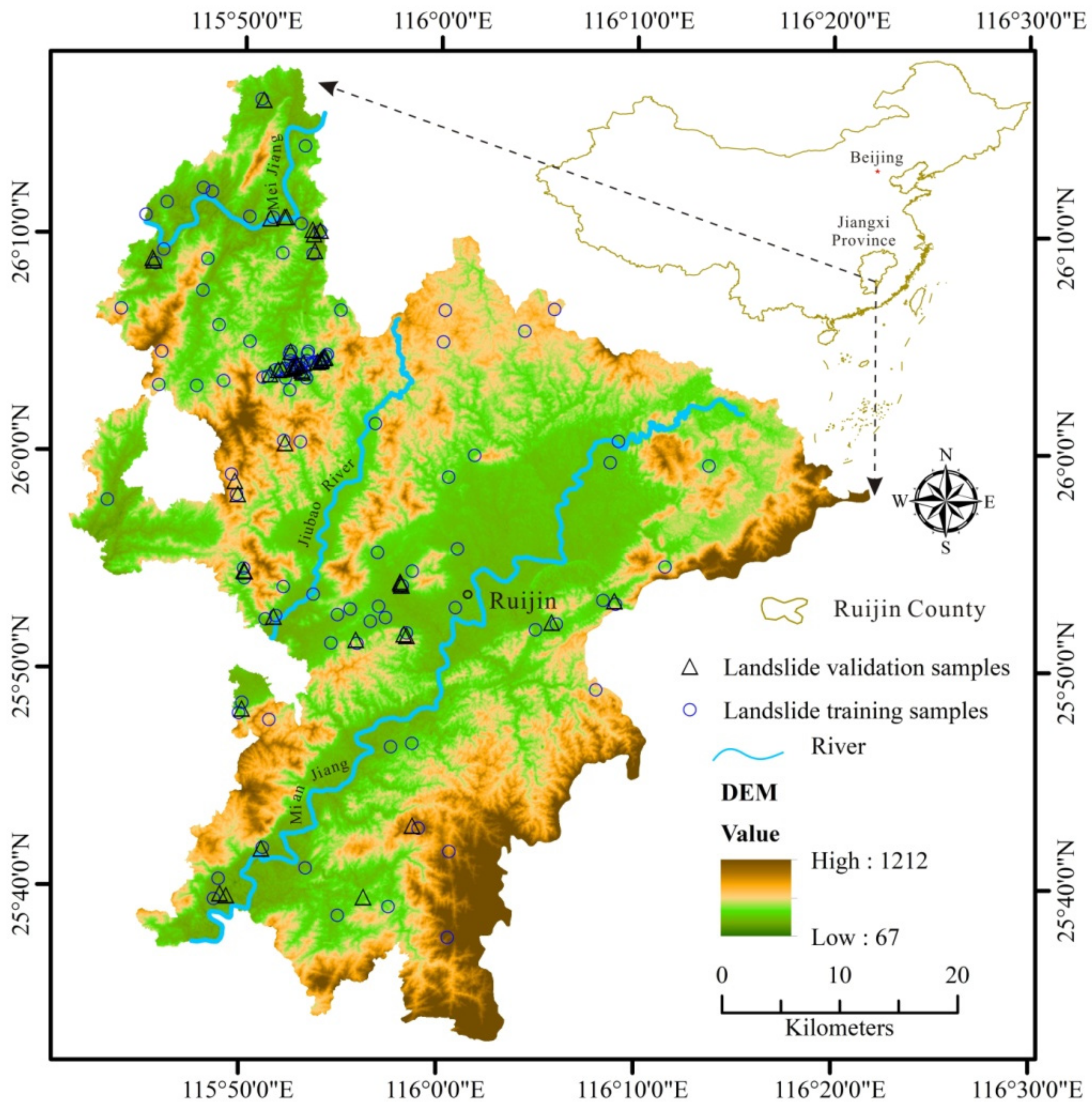
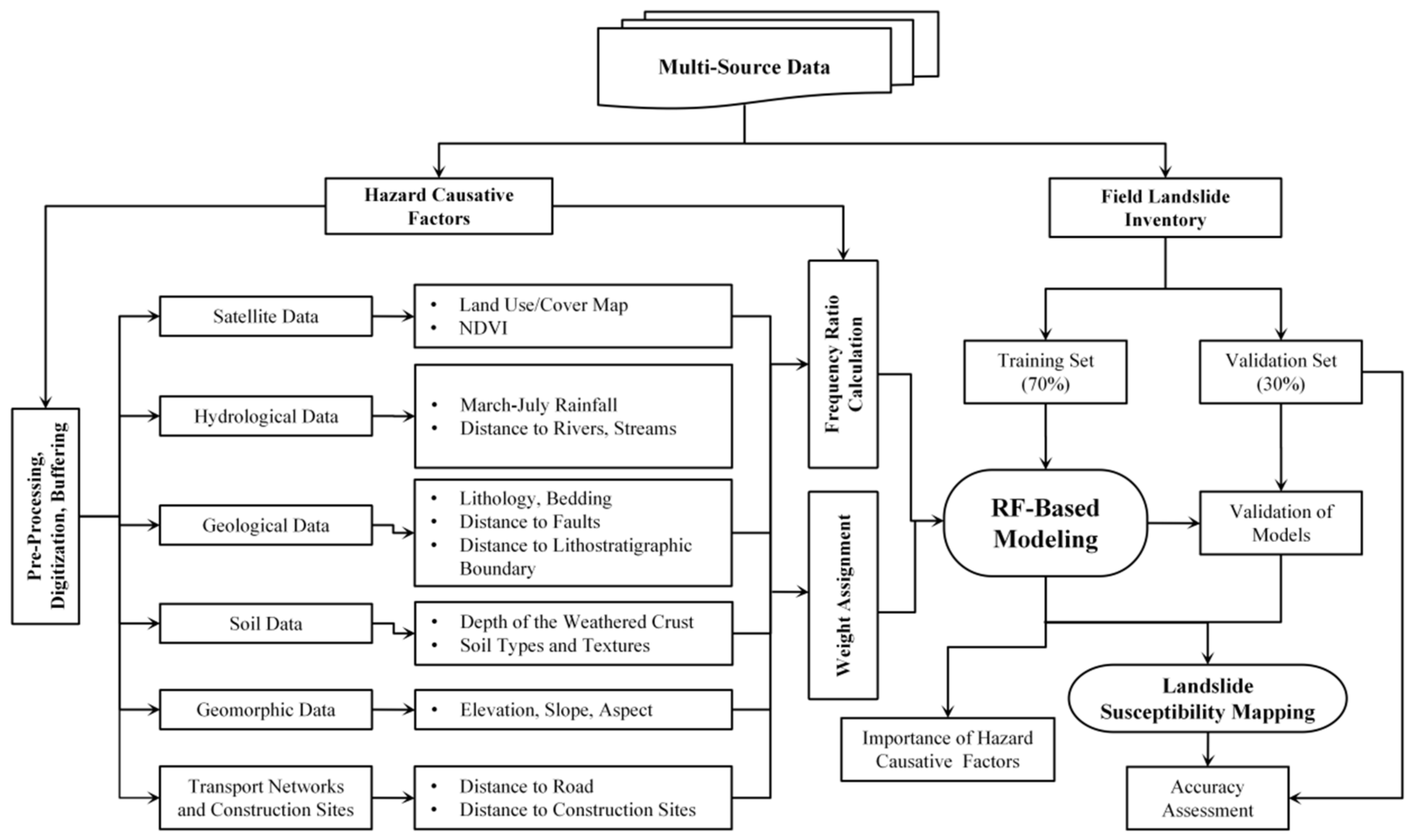
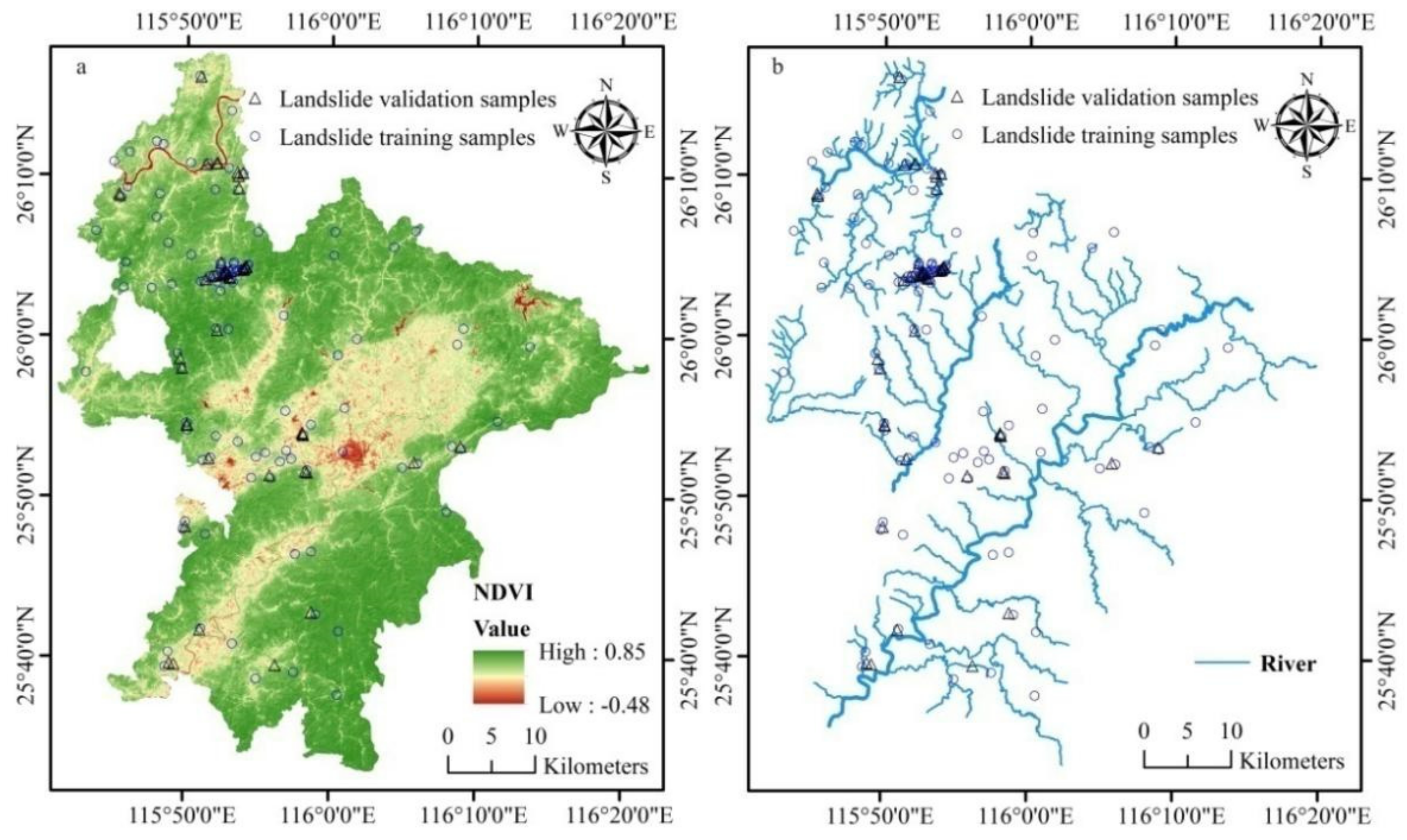


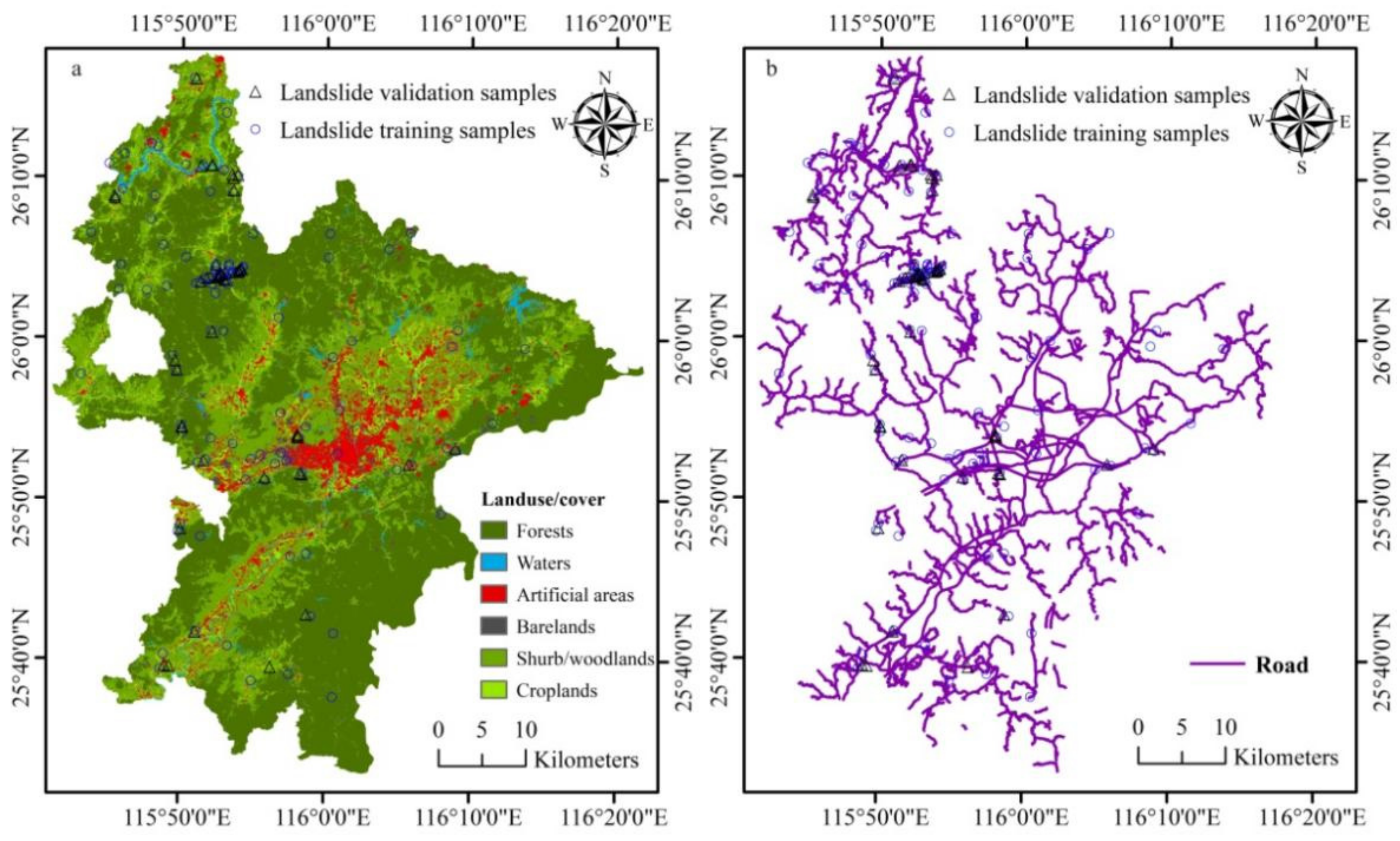


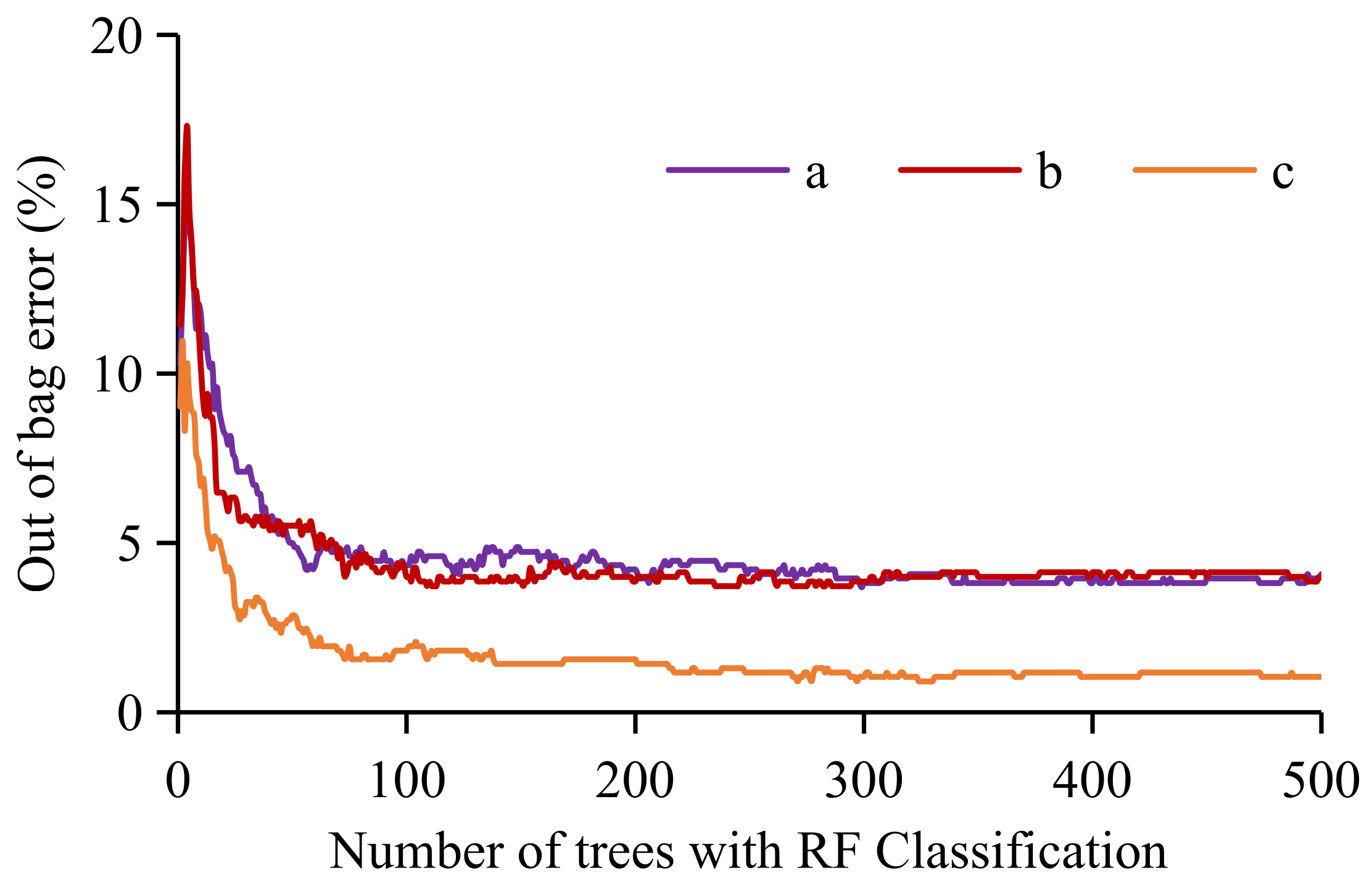
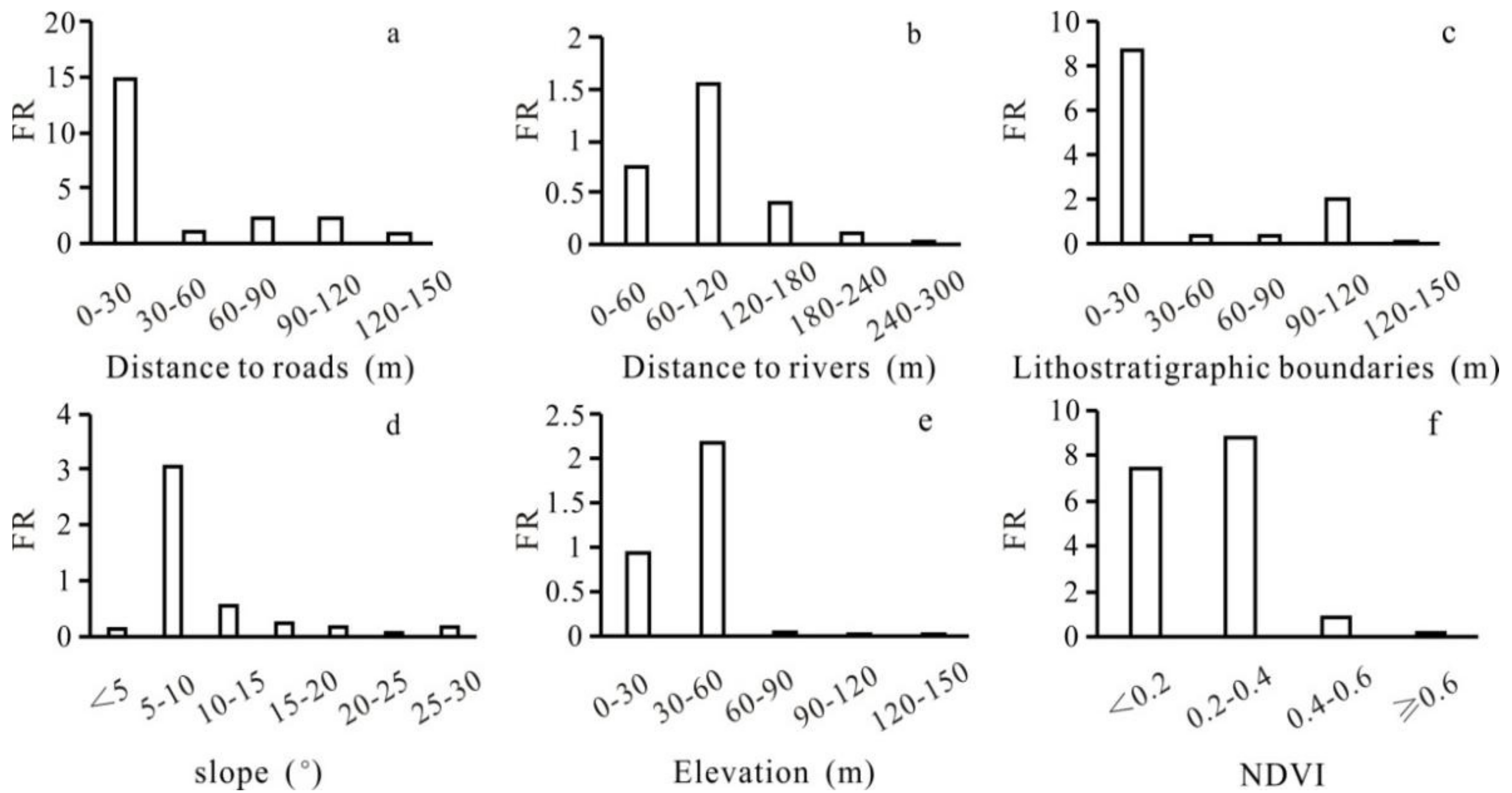
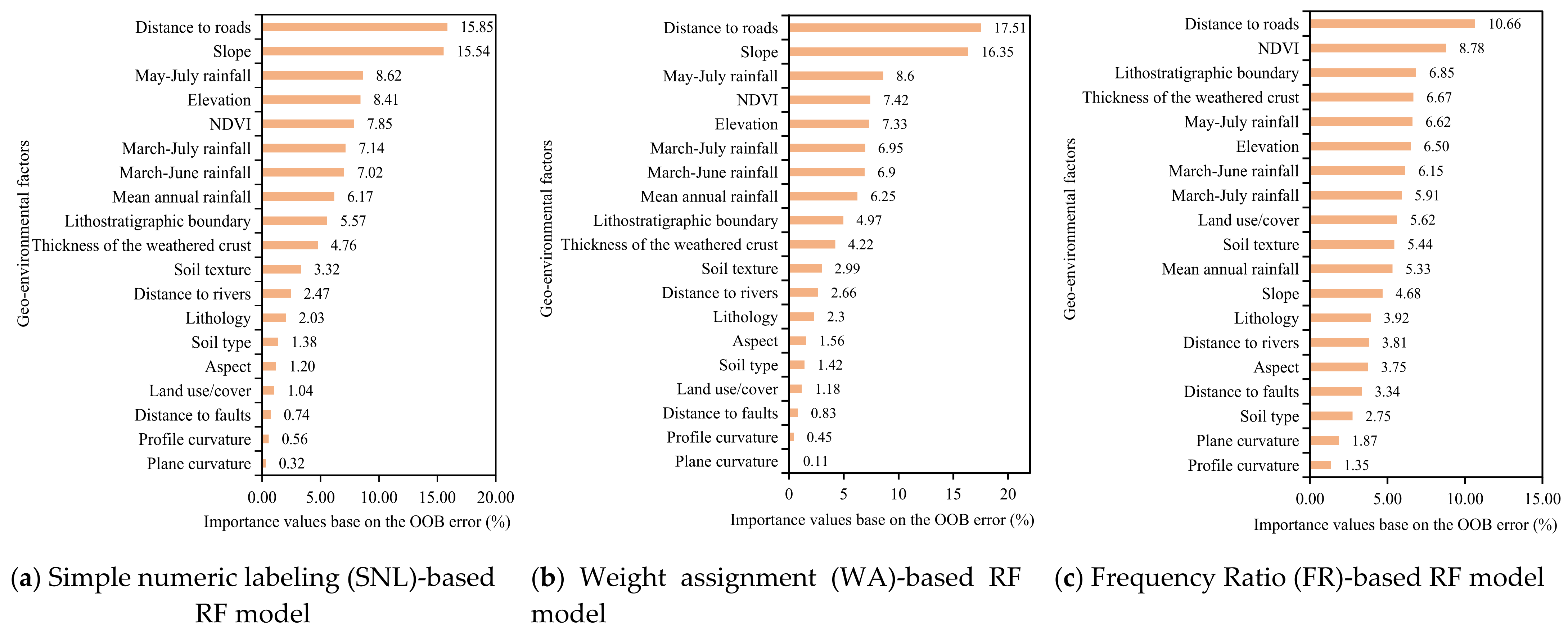
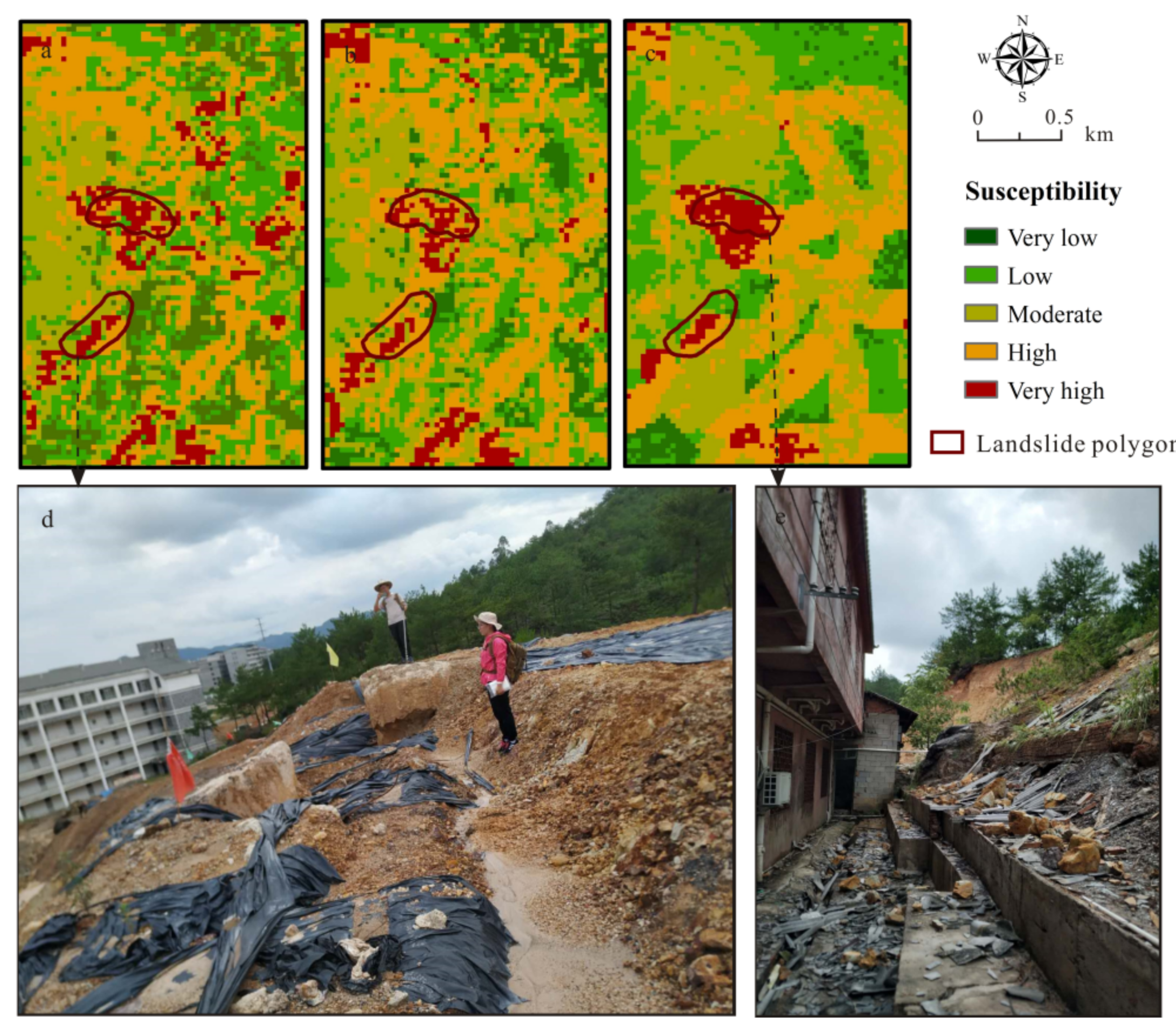
| RF Model | SNL- Based | WA- Based | FR- Based | SNL- Based | WA- Based | FR- Based | SNL- Based | WA- Based | FR- Based | SNL- Based | WA- Based | FR- Based |
|---|---|---|---|---|---|---|---|---|---|---|---|---|
| Susceptibility Level | Area (km2) | Percentage (%) | Number of Historical Landslides | Percentage (%) | ||||||||
| Very High | 118.72 | 107.13 | 135.32 | 4.86 | 4.39 | 5.13 | 132 | 137 | 135 | 85.16 | 88.39 | 87.10 |
| High | 437.27 | 363.78 | 212.66 | 17.92 | 14.91 | 12.70 | 18 | 14 | 14 | 11.61 | 9.03 | 9.03 |
| Medium | 665.71 | 545.69 | 364.47 | 27.28 | 22.56 | 18.79 | 3 | 1 | 5 | 1.94 | 0.65 | 3.23 |
| Low | 726.33 | 745.11 | 679.71 | 29.76 | 30.53 | 25.27 | 1 | 2 | 1 | 0.65 | 1.29 | 0.65 |
| Very Low | 492.35 | 678.68 | 1048.24 | 20.18 | 27.81 | 38.12 | 1 | 1 | 0 | 0.65 | 0.65 | 0.00 |
| Item | SNL-Based RF Model (VS1) | WA-Based RF Model (VS1) | FR-Based RF Model (VS2) | SNL-Based SVM Model (VS1) | WA-Based SVM Model (VS1) | FR-Based SVM Model (VS2) |
|---|---|---|---|---|---|---|
| Precision (%) | 94.67 | 95.00 | 94.00 | 83.33 | 84.67 | 92.67 |
| Recall (%) | 85.54 | 88.67 | 95.27 | 82.78 | 83.55 | 77.65 |
| KC (%) | 79.26 | 82.99 | 89.08 | 63.37 | 65.50 | 66.00 |
| OA (%) | 89.61 | 91.49 | 94.54 | 81.79 | 82.86 | 83.00 |
Publisher’s Note: MDPI stays neutral with regard to jurisdictional claims in published maps and institutional affiliations. |
© 2021 by the authors. Licensee MDPI, Basel, Switzerland. This article is an open access article distributed under the terms and conditions of the Creative Commons Attribution (CC BY) license (https://creativecommons.org/licenses/by/4.0/).
Share and Cite
Zhou, X.; Wu, W.; Lin, Z.; Zhang, G.; Chen, R.; Song, Y.; Wang, Z.; Lang, T.; Qin, Y.; Ou, P.; et al. Zonation of Landslide Susceptibility in Ruijin, Jiangxi, China. Int. J. Environ. Res. Public Health 2021, 18, 5906. https://doi.org/10.3390/ijerph18115906
Zhou X, Wu W, Lin Z, Zhang G, Chen R, Song Y, Wang Z, Lang T, Qin Y, Ou P, et al. Zonation of Landslide Susceptibility in Ruijin, Jiangxi, China. International Journal of Environmental Research and Public Health. 2021; 18(11):5906. https://doi.org/10.3390/ijerph18115906
Chicago/Turabian StyleZhou, Xiaoting, Weicheng Wu, Ziyu Lin, Guiliang Zhang, Renxiang Chen, Yong Song, Zhiling Wang, Tao Lang, Yaozu Qin, Penghui Ou, and et al. 2021. "Zonation of Landslide Susceptibility in Ruijin, Jiangxi, China" International Journal of Environmental Research and Public Health 18, no. 11: 5906. https://doi.org/10.3390/ijerph18115906
APA StyleZhou, X., Wu, W., Lin, Z., Zhang, G., Chen, R., Song, Y., Wang, Z., Lang, T., Qin, Y., Ou, P., Huangfu, W., Zhang, Y., Xie, L., Huang, X., Fu, X., Li, J., Jiang, J., Zhang, M., Liu, Y., ... Liu, W. (2021). Zonation of Landslide Susceptibility in Ruijin, Jiangxi, China. International Journal of Environmental Research and Public Health, 18(11), 5906. https://doi.org/10.3390/ijerph18115906








